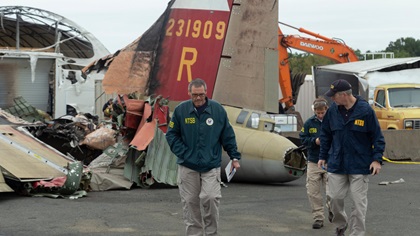New details of B–17 crash emerge
A preliminary NTSB report on the fatal October 2 crash of a vintage Boeing B–17 Flying Fortress in Connecticut includes evidence that the aircraft may have had trouble with more than one of its four engines.
Seven people including the pilot, co-pilot, and five passengers died after the Boeing B–17G operated by the Collings Foundation crashed 1,000 feet short of the Bradley International Airport runway the crew was attempting to return to.
The flight departed at 9:47 a.m. with three crewmembers and 10 passengers aboard. One of the pilots requested a return to the airport within three minutes, the NTSB report states. The crew reported a “rough mag” on the No. 4 engine and acknowledged a landing clearance from the tower moments later. “At that time, the airplane was about 300 ft agl on a midfield right downwind leg for runway 6,” the report states.
The tower controller inquired about the flight’s progress back to the runway, and the pilot responded they were “getting there” and on the right downwind, the report states. There were no further communications. Witnesses and airport surveillance cameras confirmed the aircraft struck approach lights about 1,000 feet short of the runway, then hit the ground about 500 feet short of the runway. It continued onto the runway surface before veering right, crossing a grassy area and striking vehicles and a deicing fluid storage tank. The aircraft was largely destroyed in a post-crash fire.
The pilot, Ernest “Mac” McCauley, 75, and co-pilot Michael Foster, 71, both died in the crash. Five passengers taking part in a flight operated under the FAA Living History Flight Experience exemption were also killed; five other passengers and one crewmember were hurt, four of them seriously. One of the five passengers and one person on the ground suffered minor injuries.

Some details in the report suggest the crew may have been trying to cope with trouble in two engines, not just one. Propellers attached to the No. 3 and No. 4 engines were found with blades in the feathered or partially feathered positions. The No. 3 engine was recovered from the top of the deicing fluid tank, and “one blade was impact damaged and near the feather position. The other two blades appeared in a position between low pitch and feather,” the NTSB report states. “One propeller blade exhibited a 5-inch tip separation and the separated tip sections were recovered from 100 ft and 700 ft from the main wreckage. The No. 4 engine was recovered from the deice building. All three propeller blades on the No. 4 engine appeared in the feather position.”
A fuel sample recovered from one of two fuel tanks supplying the No. 3 engine was found to be free of contamination, the report states. There is no mention of fuel testing or contamination that might have affected any of the other engines.
At the time of the aircraft's most recent annual inspection on January 16, three of the four engines had zero hours since major overhaul; the No. 4 engine had 838.2 hours since its last major overhaul, the report states. The airplane underwent a 100-hour inspection on September 23, part of an airworthiness inspection program that included annual inspections, as well as 25-hour, 50-hour, 75-hour, and 100-hour progressive inspections in between annual inspections, the report states. The aircraft had flown 268 hours since the previous annual inspection at the time of the crash.
The report also noted that inspection of the wreckage determined that jackscrews, which actuate the flaps, were found in a position consistent with the flaps being retracted.
The Collings Foundation of Stow, Massachusetts, operated the B–17G known as Nine O Nine, and suspended the Wings of Freedom Tour for the remainder of the year soon after the crash. The organization recently emailed supporters seeking help advocating for continuation of the Living History Flight Experience exemptions:
“In the coming months, federal agencies will be reviewing the LHFE program for not only our organization, but many other organizations nationwide who continue to fly vintage aircraft as a part of their educational mission. As these reviews take place, we feel it is important for the voices of those impacted by the Wings of Freedom Tour over the years to be heard. We need to let federal agencies know that the LHFE program is important to you and other American citizens as an educational tool.”
Hundreds of comments were submitted following that email: As of October 15, more than 1,200 comments were posted on the public docket, with the overwhelming majority urging the FAA to continue the program. (No comments to the contrary were found during a search of the online docket.) Among those many supporters was Connecticut Air and Space Center Curator Christopher Soltis, who wrote urging extension of the Collings Foundation’s exemption: “If anything, more organizations should be encouraged to allow passengers to fly in these pieces of history.”
Sen. Richard Blumenthal (D-Conn.) has asked the FAA to review the applicable regulations, and questioned, in a statement reported by the Hartford Courant, the recency of the accident aircraft’s inspections.
“Overall, I would say that this report is consistent with my last urging to the FAA that it review the conditions for the exemption. There’s been another application for the extension of that application. The FAA will have to make a decision about that exemption for continued operation of the B–17s that belong to Collings,” Blumenthal told the newspaper. “My expectation is that it will want to consult with the NTSB before the final report is issued because the exemption expires in March and probably the report will not be done until after that.”




